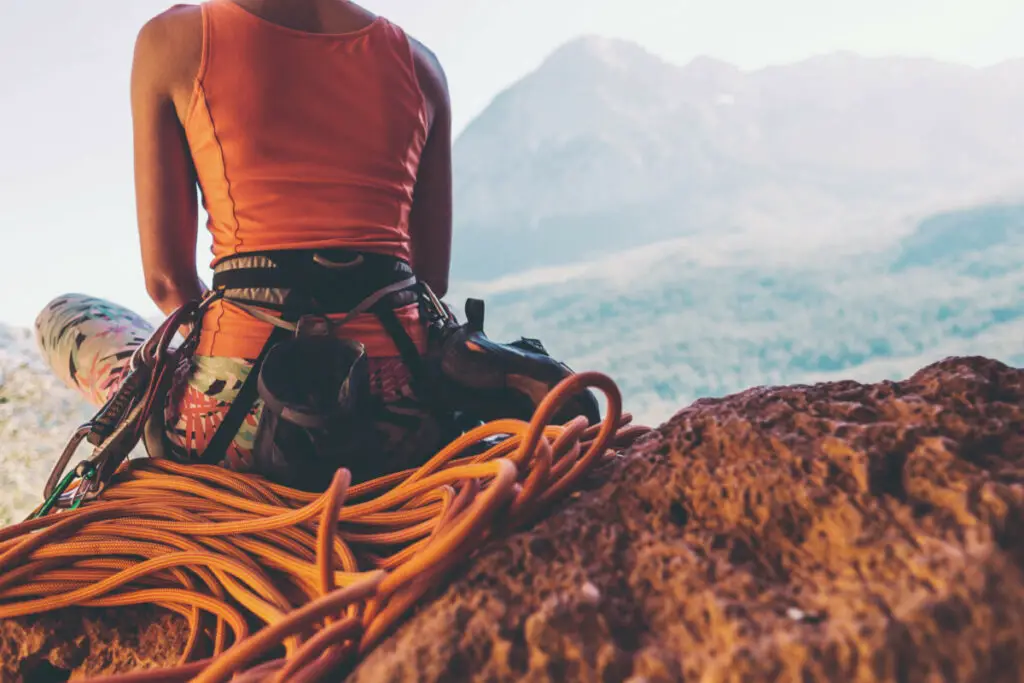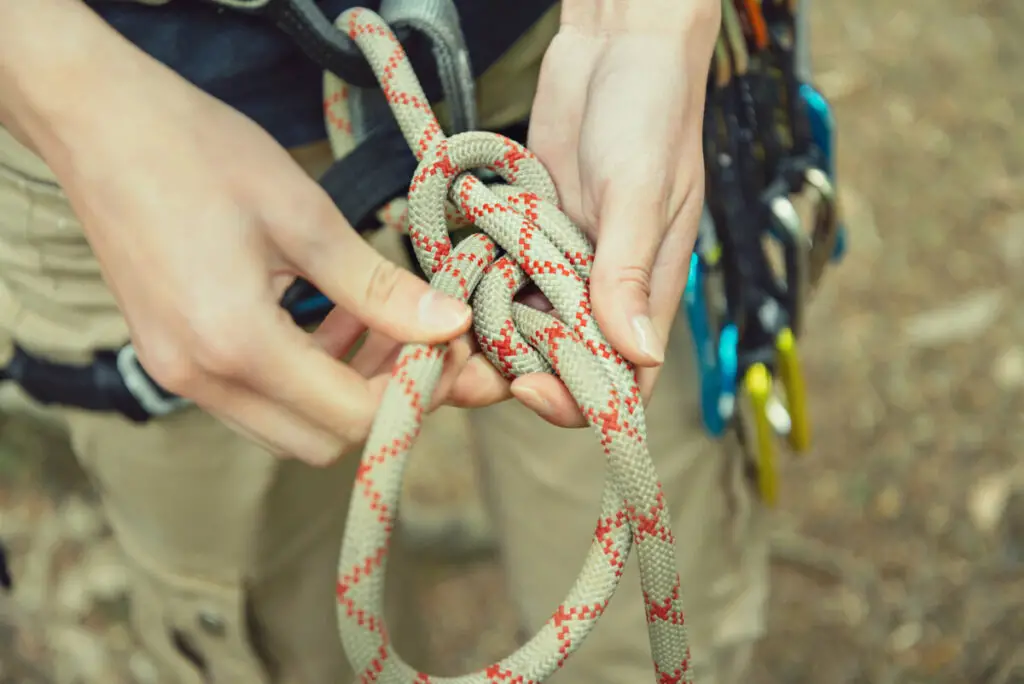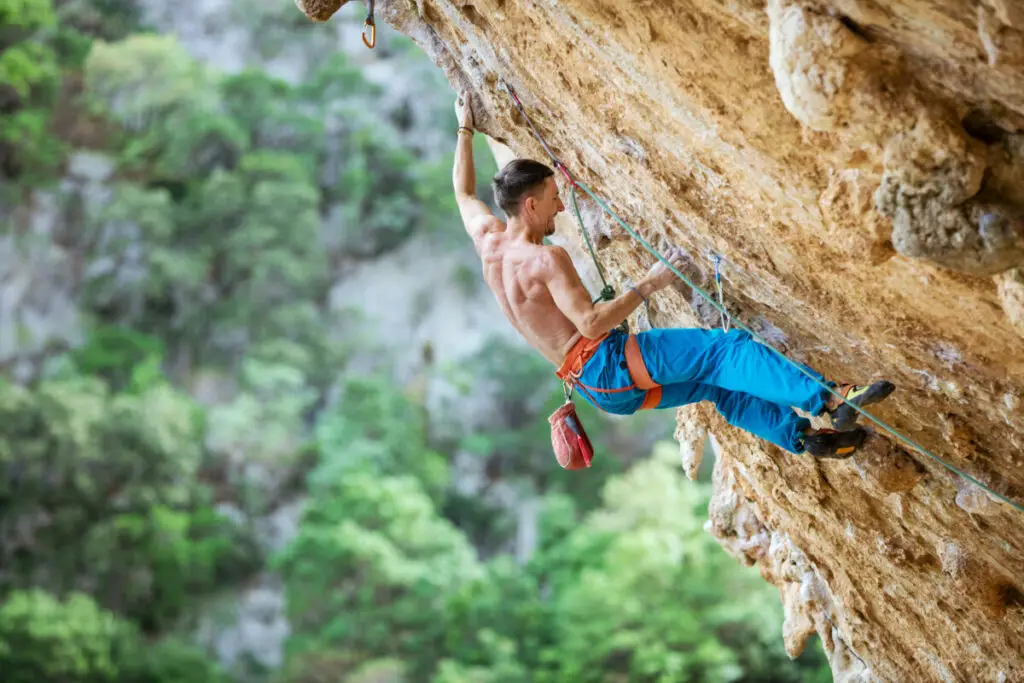
A climbing rope is quite an investment. Ropes range greatly in pricing and it is hard to know whether or not you may be sacrificing durability or safety by saving money and spending less on one. However, exactly how much do climbing ropes cost?
A climbing rope generally costs anywhere from $110 to $350. This large range of pricing is due to different aspects of the rope such as length, diameter, weather treatment, and brand. These aspects determine what kind of climber and what type of climbing the rope is best suited for.
That being said, you should do research on multiple ropes before you decide on one. Generally, the less expensive ropes are best suited for beginners while the more expensive ones have aspects that make them more catered towards experienced climbers. Let’s talk about just ten examples of different types of ropes in different price ranges and their strengths and weaknesses so you can find the kind of climbing rope for you.
Quick Overview: Understanding the Specs
There are a lot of specs and climbing lingo you have to be familiar with in order to understand what each rope is best for. Going forward, we’ll talk about what these specs mean for you and your rope.
Safety Ratings
The safety ratings for rope are separated into four categories- fall rating, static elongation, dynamic elongation, and impact force. They all measure the safety of a climbing rope in different ways.
- Fall Rating: This means how many falls the rope can absorb before being retired, with the minimum being five UIAA-tested falls. If a rope has a higher fall rating, it will have a longer lifespan than one with a low fall rating.
- Static Elongation: The static elongation rating measures the amount of stretch a dynamic rope has in it with a non-moving weight. The standard static elongation is less than 10% of the length of the rope.
- Dynamic Elongation: Dynamic elongation is similar to static elongation, measuring the amount of stretch in a rope, but during a fall. The rating for dynamic elongation is a bit higher, not exceeding 40% of the length of the rope.
Best Use
Now this aspect of the rope is pretty straightforward. “Best use” just tells you what the rope is best used for, which when you’re looking at ropes generally means climbing or mountaineering. That being said, “best use” doesn’t specify if the rope is best used for sport, trad, or multi-pitch climbing, as you will have to look at other specs to determine that. (Source)
Rope Style
Rope style can be divided into two main styles, dynamic and static. Dynamic ropes stretch more, which makes them better for catching climbers in falls. The movement of the rope absorbs some of the impact of the fall, making it less stressful for the climber. Static ropes are best used for hauling a load, caving, or search and rescue work. They should not be used for sport climbing, as they aren’t made to withstand or absorb the force of a fall.
Rope Length
The length of your rope is a big factor in the type of climbing you can do with it. You generally need shorter ropes if you are climbing indoors at a gym and longer ones for climbing crags outside. One important thing to remember though is that you will always need a rope that is double the length of your climb. If you plan on sending a 20m route, then you will need a 40m rope so you can climb up and repel down safely.
A 60-meter-long rope will generally suit the needs of most climbers unless you intend on completing walls over 200 feet high in a single pitch. If you are unsure if your rope will be long enough for a certain route, you can look at guidebooks, ask other climbers, or use a website like Mountain Project to get some good ‘beta’ or information on the route.

Rope Diameter
Ropes generally range in diameter from 8.5 millimeters to 11 millimeters. Ropes with smaller diameters are more lightweight than those with larger diameters but are often less durable against wear and tear. This means that despite the durable sheath around the core, they often have a shorter lifespan than wider ropes.
Climbing ropes with a larger diameter are recommended for beginners. The thickness makes them easier to handle through a belay device for inexperienced climbers. They can also endure much more abrasion and many more falls, which are both more common among novice rock climbers.
A rope up to 9.4 millimeters are used by some of the most technical climbers and need to be used only by a watchful and seasoned belayer. The diameter that is most versatile ranges from 9.4 to 9.9 millimeters. Ropes of this size can be taken mountaineering or to the crag and are the perfect balance between durability and manageability. Ropes that are 10 millimeters or thicker are great for beginners to use in the gym, top-roping, or testing out new routes.
Dry Treatment
Water can wear a lot on your gear, especially a climbing rope. To avoid this, rope manufacturers have developed different ways to waterproof ropes through dry treatments. Ropes can be separated into two categories: non-dry and dry ropes. Non-dry ropes aren’t treated with a dry treatment to make them waterproof, while dry ropes are.
Since applying the treatment increases production costs, dry ropes are more expensive than non-dry ones. Dry ropes can be treated in two ways, by treating just the sheath, or by treating the sheath and the core.
You may be thinking if it is worth it to pay extra for a dry rope and it really depends on where and when you will be climbing. If you live and climb in a humid environment like the pacific northwest, it would probably be worth it. On the other hand, if you frequently climb in the desert of southern Utah, you most likely won’t need a rope that has a dry treatment.
Weight
The weight of a rope isn’t too much of a factor when you are climbing, but can be important in the approach. If you generally climb in areas where there is a long approach to the crag, it may be worth it to get a rope that weighs less to save your back.
Examples of Ropes with their Specs and Prices
To give you an even better idea of what you get for money when buying a rope, we’ve compiled a table of different options for ropes, their specs, and their prices.
| Type of Rope | Price | Best use | Rope Style | Rope Length | Rope Diameter | Dry Treatment | Weight |
| Mammut Gym Classic | $109.95 | Climbing | Dynamic | 40m | 9.5mm | Non-Dry | 59g/m |
| Edelrid Boa Eco | $119.95 | Climbing | Dynamic | 40m | 9.8mm | Non-Dry | 62g/m |
| PMI E-Z Bend Sport | $140.95 | Climbing | Static | 150ft | 11mm | Non-Dry | 11.9g/ft |
| Sterling VR9 | $184.95 | Climbing | Dynamic | 60m | 9.8mm | Dry Core | 62g/m |
| Mammut Crag Classic | $159.95 | Climbing | Dynamic | 60m | 10.2mm | Non-Dry | 67g/m |
| Black Diamond | $219.95 | Climbing | Dynamic | 70m | 9.2mm | Non-Dry | 58g/m |
| Beal Karma | $174.95 | Climbing | Dynamic | 70m | 9.8mm | Non-Dry | 61g/m |
| Sterling Quest XEROS | $249.95 | Climbing | Dynamic | 60m | 9.6mm | Dry Rope | 9lbs 6.6oz |
| Mammut Crag Duodess | $309.95 | Climbing | Dynamic | 70m | 9.5mm | Dry Rope | 59g/m |
| Black Diamond Ondra Edition | $349.95 | Climbing | Dynamic | 80m | 8.6mm | Dry Rope | 50 g/m |
Now let’s do an even deeper analysis of these ropes and how these aspects and specs factor into the cost.
Mammut Gym Classic
The Mammut Gym Classic is a good beginner rope. Like it says in the name, this rope is best suited for climbing in the gym because of its short length. Although it can be used at the crag, it isn’t the most versatile rope for climbing outdoors because it is short. The rope handles well with different belay devices like an ATC and a grigri.
Edelrid Boa Eco
The Edelrid Boa Eco is one of the most eco-friendly ropes on the market. Edelrid makes the rope from high-quality yarn left over from production. Although it is made with scraps, this rope is still of high quality containing a stretchy inner core and durable outer sheath.
Reviews say it is great for climbing indoors and outdoors as well as having one of the best price-to-performance ratios. The stretchy core means you will experience soft catches, making it easy on both the belayer and the climber.
The Boa Eco rope is unique because of its thermal shield which ensures that the rope remains supple throughout its lifetime. Hash marks at the midpoint make it easy and safe leading and on multiple pitches.
PMI E-Z Bend Sport
The main factor to consider about the PMI E-Z Bend Sport rope is that unlike the other ropes we have discussed which are all dynamic, it is a static rope. This means that it isn’t suited for climbing and catching falls but more for lowering heavy loads.
This rope is best suited for cavers and search and rescue teams, not rock climbers. One pro this rope does have is enhanced flexibility, which makes it easy to knot and untie, which is especially important in search and rescue situations.
Sterling VR9
The Sterling VR9 is a great all-around rope. Both beginners and experienced climbers alike recommend using this rope. It has a specialized core treatment to protect it from dirt and water as well as a kernmantle. The kernmantle consists of a stretchy core and durable outer sheath which give the rope good strength, durability, and handling.
The Sterling VR9 isn’t too heavy which means you can use it even if there’s a long approach to your route. These ropes are made in the United States and you can even send them back to the facility to be recycled when it has reached the end of their life.
Mammut Crag Classic
The Mammut Crag Classic is a climbing classic. Climbers have said it is not only a good first rope but a workhorse that you can use for a long time. The rope is durable and versatile and can be used indoors and outdoors. The thicker diameter of 10.2mm gives the rope its durability and ability to be handled a bit more roughly than thinner more technical ropes.

Black Diamond
This particular Black Diamond rope is 70 meters long with a 9.2mm diameter. These specs make it a versatile, ultralight, and durable rope. Although it can be used by beginners, this rope is well suited for high-performance, hard climbing. The rope is woven into a 1×1 weave to fight abrasion. A triple dash middle marker as well as the flexibility of the rope make it easy to handle.
Beal Karma
The Beal Karma rope is designed to cover any type of climbing you can throw at it, all without using any chemical treatments or dye. Despite its versatility, users have reported that the rope has a shorter life expectancy than they were hoping for.
Sterling Quest XEROS
Sterling is an environmentally friendly manufacturer. The facility where they produce high-end climbing ropes like the Sterling Quest XEROS is run on 100% renewable energy and offsets 100% of their carbon emissions. The majority of the yarn fibers are made into finished products, but what is not used gets either recycled or upcycled.
Along with the positive environmental aspects of the rope, the Sterling Quest XEROS can be used by every climber in every discipline and is a thinner version of Sterling’s popular Velocity rope. Each fiber of yarn receives a dry treatment, ensuring that your rope will stay clean and dry.
Mammut Crag Duodess
The Mammut Crag Duodess is a rope made for more experienced climbers who plan on doing sports or traditional routes. The dual Duodess pattern makes it easy to tell how much rope you have left at a glance.
Mammut manufactures the Crag Duodess with a special treatment making it more resistant to abrasion than your average rope. Although expensive, this rope is worth every penny and has only received five-star reviews.
Black Diamond Ondra Edition
This Black Diamond rope is a special edition rope designed by professional athlete and climber, Adam Ondra. It has the smallest diameter of any climbing rope manufactured by Black Diamond. This means it is not a good option for beginners and is in fact put to its best use on long, challenging routes. The rope also features minimal drag and a triple dash middle marker. A classic 2×2 weave of the rope fibers gives it flexibility as well as a long lifespan.

